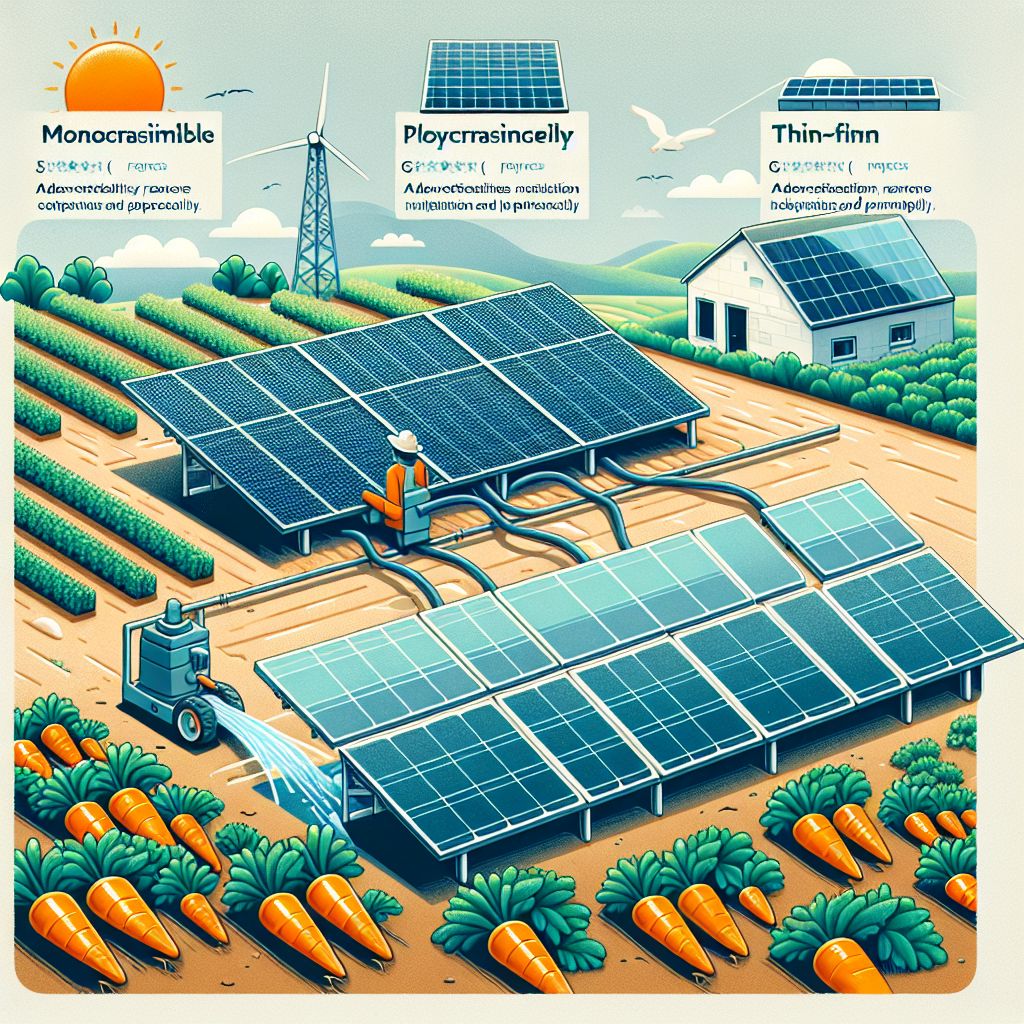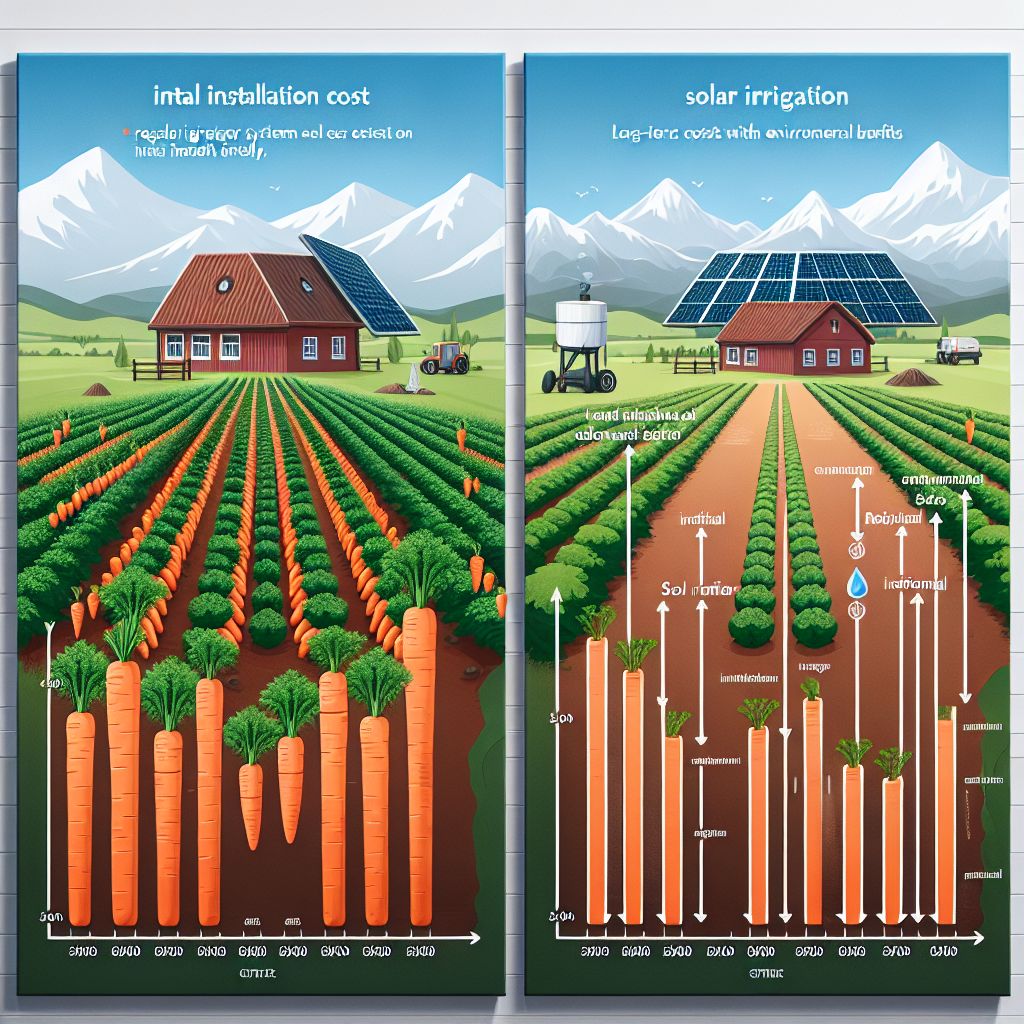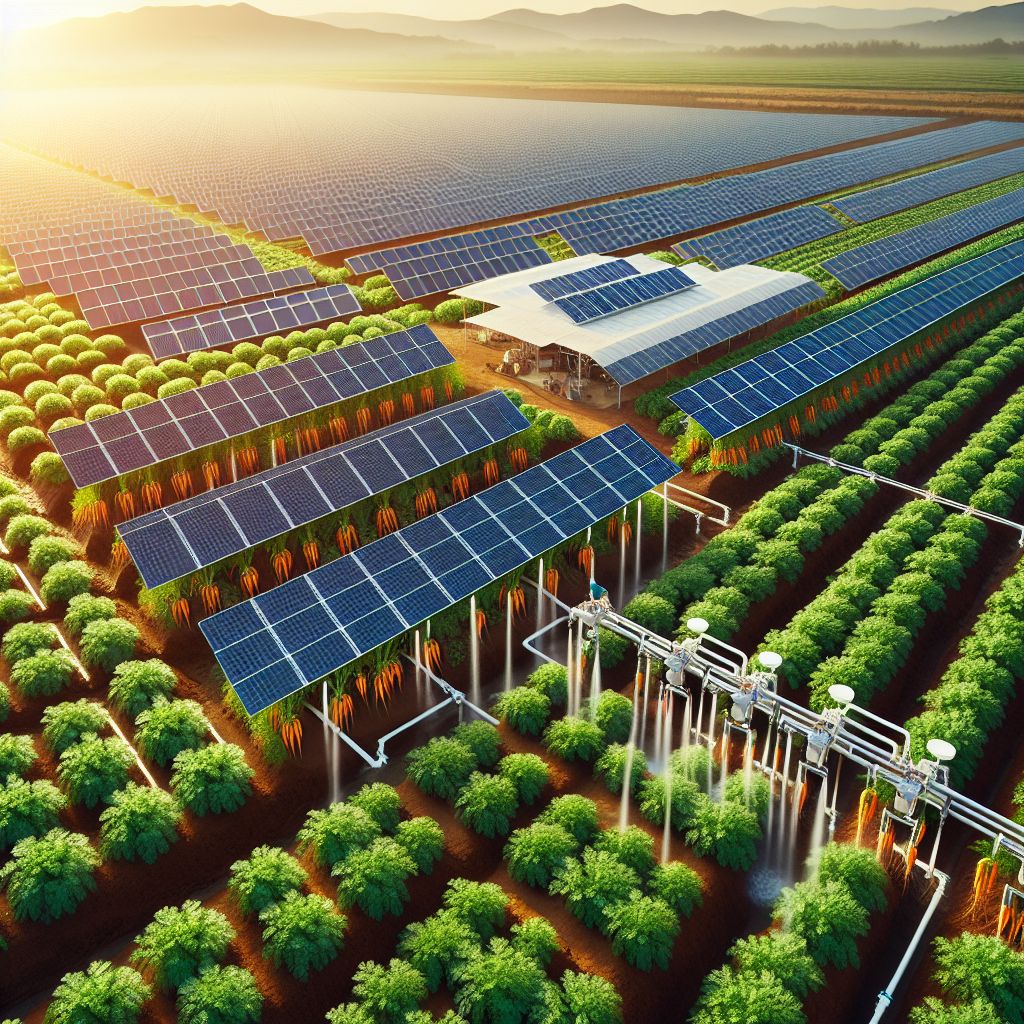
Let’s dive into a smarter way to grow carrots. Picture a field of carrots, basking in the sun, and watered by that same sun. Yes, solar-panel irrigation systems are changing the game when it comes to farming these tasty, healthy treats. But before we get into the weeds, let’s quickly review what you’ll learn from this guide.
Main Points
Solar panels can drastically cut the energy costs of watering carrot crops.
Drip irrigation systems are accurate and water-saving, perfect for carrots.
Sprinkler systems can cover vast areas, making them appropriate for large carrot farms.
Monocrystalline solar panels, although pricier, provide high efficiency for farm irrigation systems.
Merging solar power with irrigation can result in long-term savings and eco-friendly farming methods.
The Reason to Merge Solar Panels with an Irrigation System
Consider this. Sunlight is free, and it’s plentiful, particularly on a farm. By using solar energy to run irrigation systems, we’re utilizing a sustainable resource that’s beneficial for the earth and our wallets. It’s a double victory: we reduce our electricity bills, and we move towards greener farming.
Advantages of Solar Power in Farming
What’s the big deal about solar power in farming? It’s environmentally friendly, it’s sustainable, and it’s fast becoming a vital part of the future of agriculture. By using solar panels, we can take the energy from the sun and turn it into electricity to power our irrigation systems. This means we’re not just saving money on energy, we’re also cutting down on our carbon emissions.
Saving Water and Power
Water is valuable, and so is energy. By pairing solar panels with effective irrigation systems, we are ensuring that every drop of water and every beam of sunlight is used to its maximum capacity. This method is not just about being environmentally friendly; it’s also about being financially savvy.
Boosting Independence in Farming
Crucially, the use of solar panels allows us to be more independent. Think about not having to depend so much on the grid, particularly in isolated farming regions. With a solar-powered irrigation system, we can ensure our carrots continue to grow even if there’s a power outage.

Various Irrigation Methods for Carrot Farming
It’s time to dig into the two primary irrigation methods for carrot farming: drip and sprinkler systems. Each system has its own benefits, and selecting the right one can significantly impact your yield.
Drip Irrigation: A Smart Watering System for Carrot Crops
Imagine this: a maze of tubes that provides water directly to the base of each carrot plant. This is what drip irrigation is all about. It’s like giving each carrot its own personal watering system, making sure that water goes exactly where it’s needed and reducing waste.
Sprinkler Systems: A Boon for Large Carrot Farms
Meanwhile, sprinkler systems are akin to summoning rain whenever you need it. They are capable of covering vast expanses effectively, making them perfect for large carrot farms. The trick is to use them judiciously to prevent water from evaporating or being carried away by the wind.
Here is a table summarizing the pros and cons of different irrigation systems for growing carrots:
|
Irrigation System |
Pros |
Cons |
|---|---|---|
|
Drip Irrigation |
– Efficient water usage, minimizes evaporation and runoff. 1, 3, 4 |
– Initial installation can be expensive. 1, 3 |
|
Sprinkler/Overhead |
– Inexpensive to install. 1, 4 |
– Promotes foliar diseases on pepper plants. 1, 4 |
What’s the Best Irrigation System for Carrot Farming, Drip or Sprinkler?
The best irrigation system for your carrot farm depends on its size. Drip systems are ideal for smaller farms that need precise watering, while sprinkler systems are best for larger farms. But no matter the system, you can power it with solar energy.

Different Solar Panels to Consider for Your Carrot Farm’s Irrigation System
There are plenty of solar panels to choose from for your irrigation system. The best one for your farm depends on your specific needs. Let’s take a look at the various solar panels that can help your carrots grow well.
Monocrystalline Panels: Where Efficiency Meets Carrot Farming
Monocrystalline solar panels are the overachievers of the solar family. They’re made from a single, pure silicon crystal, which makes them incredibly efficient at converting sunlight into electricity. They’re also robust and have a long lifespan, which is ideal for the long-term investment in your carrot farm’s future.
Polycrystalline Panels: A Budget-Friendly Choice for Irrigation
Polycrystalline panels, which are made from several silicon crystals, are somewhat akin to the more pragmatic sibling of monocrystalline panels. While they’re a bit less efficient, they’re also more affordable. If you’re looking to reduce initial expenses while still getting dependable results, these could be your best bet.
Now, you might be asking, “But there’s more to it, isn’t there?” Indeed, there is. Thin-film solar panels are the newest addition to the solar panel family. They are light, flexible, and can be an excellent choice for farms with large areas.
Thin-Film Solar Panels: Flexibility in Installation
Thin-film panels are just as they sound: thin layers of solar cells on a base material. This makes them light and flexible, which means they can be installed in many places, even on surfaces that are not flat. They’re not as efficient as mono and polycrystalline panels, but they make up for it in flexibility and ease of installation.
However, when it comes to choosing the best solar panel for your carrot farm, there are a few factors to consider: efficiency, cost, durability, and the specific needs of your farm. It’s not a one-size-fits-all situation, and the best choice will depend on your individual circumstances.
Right below is a table looking at all the different solar panel options:
|
Solar Panel Type |
Efficiency Range |
Advantages |
Disadvantages |
|---|---|---|---|
|
Monocrystalline |
17-22% |
Highest efficiency, space-saving, long lifespan. 2 | |
|
Polycrystalline |
15-17% |
Lower efficiency, requires more space. 2 | |
|
Thin-Film |
10-13% |
Lightweight, flexible, good temperature coefficient. 2 |
Lowest efficiency, requires large area. 2 |
|
Portable Solar Panel Systems |
Varies based on panel type |
Designed for irrigation needs, easy to move and relocate. 1, 3 | |
|
Hybrid Solar Panels |
Varies based on components |
Can combine solar with other energy sources like wind, increased reliability. 4 |
More complex system, higher cost. 4 |
Monocrystalline panels provide the highest efficiency in a compact area but at a higher upfront cost (2, 3). Polycrystalline panels offer a balance of efficiency and cost (2, 3). Thin-film panels have lower efficiency but perform better in high temperatures (2). Portable solar panel irrigation systems allow flexibility in placement and relocation as needed (1). Hybrid systems increase reliability by combining solar with other renewable sources but add complexity (4). The optimal choice depends on factors like available space, budget, local climate conditions, and specific irrigation requirements for the carrots.
Choosing the Right Solar Panel for Your Carrot Farm
The ideal solar panel for your carrot farm will be the one that strikes the right balance between efficiency and cost, based on your specific requirements. Monocrystalline panels are the most efficient, polycrystalline panels are a cost-effective option, and thin-film panels provide flexibility in installation. It’s important to consider the size of your farm, your budget, and your setup when making your decision.

Comparing the Cost and Efficiency of Solar Irrigation Systems and Regular Irrigation Systems for Carrot Farming
Let’s get down to brass tacks. Solar irrigation systems can appear to be a hefty initial investment, but when we compare them to regular irrigation systems over time, how do they measure up?
Initial Installation Costs Comparison
It’s true that solar irrigation systems are more expensive to install than traditional ones. However, don’t be deceived by the upfront costs. The real benefits of solar irrigation systems become apparent when you consider the long-term savings.
Let’s take a quick look at the differences:
While a conventional irrigation system may have a lower initial cost, you’ll be faced with recurring energy bills.
Although a solar-powered system has a higher upfront cost, the continuous energy expenses are virtually non-existent.
It’s similar to spending a little more on a high-quality tool that will last you a long time, as opposed to purchasing a cheaper one that needs to be replaced frequently. In the long run, the high-quality tool will save you money.
Financial and Environmental Benefits Over Time
Moreover, the long-term benefits are substantial. Solar irrigation systems can drastically cut your water and energy consumption, which is not only beneficial for your budget but also for the environment. Plus, in many areas, you may qualify for tax breaks or grants for using renewable energy, which can help to recoup the upfront costs.
Indeed, the initial costs of a solar irrigation system might be steep, but the long-term savings and eco-friendly advantages make it a wise decision for sustainable carrot farming. It’s about putting money into the future of your farm and our planet.
This table compare the pros and cons of solar-powered irrigation systems and conventional irrigation systems:
|
Aspect |
Conventional Irrigation System |
Solar-Powered Irrigation System |
|---|---|---|
|
Pros |
No ongoing energy costs, uses free solar power. 5 | |
|
Simple installation and maintenance. 1 |
Environmentally friendly, reduces carbon footprint. 3 | |
|
Reliable water supply even during power outages. 5 | ||
|
Long lifespan of solar panels (25-30 years). 5 | ||
|
Cons | ||
|
Susceptible to power outages. 5 |
Requires some technical knowledge for installation/maintenance. 3, 4 | |
|
Environmental impact from energy use. 3 |
Risk of over-abstraction of groundwater if not managed properly. 3, 4 | |
|
Potential for water waste/inefficiency. 1 |

Conclusion: What is the Best Combination of Solar Panels and Irrigation system to be Most Efficient on a Carrot Farm
The ideal combination of solar panels and irrigation systems for a garlic farm depends on several factors, including the location of the farm, the climate, the size of the farm, and the budget of the farmer. Monocrystalline solar panels in combination with a drip irrigation system are highly efficient for smaller farms or those with a larger budget. Polycrystalline panels are a cost-effective alternative for farms that are new to solar power. For larger farms or those with a variety of landscapes, thin-film panels offer the most flexibility in installation and can still provide the necessary power for efficient irrigation.
Solar-powered irrigation shines in its ability to deliver water straight to the roots of plants, reducing water waste and energy use. When selecting the best system, it’s key to weigh the long-term savings in energy costs, the benefits to water conservation, and the potential for increased carrot yield and quality. Choosing solar-powered irrigation is not just a financial decision, but a dedication to sustainable farming practices that can pay off for years to come.
Is it a Good Idea for a Farmer to Upgrade His Irrigation System to Solar Powered?
Switching to a solar-powered irrigation system is an investment that can have many benefits for farmers. The decrease in ongoing energy expenses, the dependability of a renewable energy source, and the environmental benefits make it an attractive option. Even though the upfront cost may seem high, the long-term savings and potential for increased crop yields make it a good investment. Also, as the global market increasingly values sustainable practices, using solar irrigation can also improve the marketability of a farm’s produce.
Frequently Asked Questions (FAQ)
You may have some questions about solar-panel irrigation systems for carrot farming, and I have the answers. Here are some of the most frequently asked questions:
Why Should I Use a Solar-Powered Irrigation System for My Carrot Farm?
There are several reasons why a solar-powered irrigation system can be beneficial for your carrot farm:
Lower Energy Costs: Solar panels create free power from sunlight, which can cut your energy bills.
Eco-Friendly: Solar power is a clean, renewable source of energy that can help you reduce your carbon footprint.
Greater Self-Sufficiency: Solar panels can help your farm become less dependent on the grid, providing energy security.
Minimal Maintenance: Once they’re installed, solar panels require very little maintenance.
Long-Term Cost Savings: While the initial cost is higher, solar systems can save you money in the long run.
How Do Solar Panels Affect the Efficiency of a Carrot Farm’s Irrigation System?
Solar panels can enhance the performance of your irrigation system by supplying a steady and dependable source of energy. They make sure your irrigation system operates at its best, without having to worry about changing energy prices or power cuts. Additionally, they can be used in conjunction with smart irrigation technology to increase efficiency even further.
Case Study: A carrot farmer in California switched to solar panels and cut his irrigation energy costs by 75% without sacrificing his crop yield.
Is it Possible to Use Solar-Powered Irrigation for My Small Carrot Garden?
Definitely! Solar-powered irrigation isn’t only for big farms. Small gardens can take advantage of it as well. Solar panel kits come in a variety of sizes and can be a wonderful way to keep your garden flourishing while also being environmentally friendly.
What Kind of Solar Panels Work Best for Irrigation Systems?
The best solar panels for irrigation systems are the ones that meet your unique requirements:
Monocrystalline Solar Panels: These are perfect for those who need high efficiency and are looking for a long-term investment.
Polycrystalline Solar Panels: This is a more affordable option that still performs well.
Thin-Film Solar Panels: These are great for those who need flexible installation options and have a lot of space.
Would It Be Worth It to Switch My Current Irrigation System to Solar?
Switching to solar can be a financially savvy move when you factor in long-term energy cost savings and possible incentives. It’s essential to perform a cost-benefit analysis, which should include your current energy costs, the price of installing solar, and the projected lifespan of the solar system.
Moving to a solar-panel irrigation system for your carrot farm is an eco-friendly move that aligns with a future where farming works in harmony with the environment. It’s about using innovation to care for our crops and our planet. By making informed decisions about the systems and techniques we use, we can increase our carrot yield and our profits, while keeping our environmental footprint as small as possible. It’s time to let the sun shine on a new era of farming.







Leave a Reply